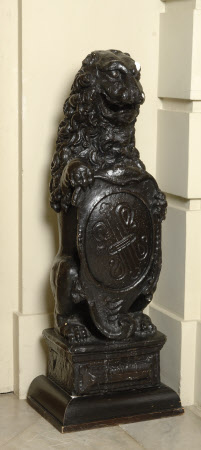A heraldic lion supporting a shield
British (English) School
Category
Art / Sculpture
Date
c. 1830 - 1850
Materials
Plaster
Measurements
1060 mm (H); 393 mm (W); 299 mm (D)
Order this imageCollection
Kingston Lacy Estate, Dorset
NT 1254477.1
Summary
Sculpture, plaster; a heraldic lion; British; c. 1830-50. A seated heraldic lion supporting a shield with a fleur-de-lys, part of the coat-of-arms of the Bankes family. One of a pair of seated heraldic lions, this one a copy in plaster of the other one (NT 1254477.2), which is of oak wood. The copy was made so the two lions could form a pair.
Full description
A figure of a lion in the position known in heraldry as "sejant-rampant", seated on its haunches, with its body erect and both forepaws raised. Its head is turned to its left, whilst in its paws the lion holds an irregular-shaped shield emblazoned with a fleur-de-lys, part of the coat-of-arms of the Bankes family. Mounted on a rectangular plinth. This is a copy in painted plaster of an oak wood lion (NT 1254477.2), created so as to form a pair. Lions have historically played an important role in heraldry, in which they are often been used to support coats-of-arms. This lion supports a shield with a fleur-de-lys, a stylised floral motif best-known as forming a key element in French royal heraldry. However, silver fleur-de-lys were also an important element in the device on the shield from the Bankes family coat-of-arms, granted in 1613 (see NT 1251333), described as ‘sable, a cross engrailed ermine between four fleur-de-lys argent'. Whereas the oak wood lion on which it is based may have been made as early as the seventeenth century, this copy was most probably made in the 1830s, when the architect Charles Barry (1795-1860)carried out extensive works to the house on behalf of William John Bankes, beytween 1835 and 1841. A set of four stone lions, which also seem to have been modelled from the wooden lion, surmount the loggia in the style of Inigo Jones that Barry added to the east front of the house. Jeremy Warren June 2023
Provenance
Bequeathed by (Henry John) Ralph Bankes (1902-1981), together with the estates of Corfe Castle and Kingston Lacy and its entire contents
Credit line
Kingston Lacy, The Bankes Collection (National Trust)
Makers and roles
British (English) School, caster Unknown artist, sculptor
